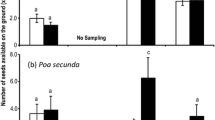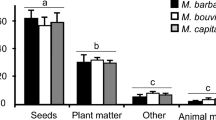Abstract
Harvester ants of the genus Pogonomyrmex collect and deposit many items on top of their nests. The depots of P. badius consist mostly of small charcoal fragments, while those of other species are primarily pebbles. Mature colonies can have hundreds of thousands of objects in their depot. In P. badius, the distributions of midden and charcoal about the mound are not completely overlapping, but are positively correlated in areas of overlap. Charcoal depots are isometric with colony size, but the amount of charcoal per colony size varies with season and site. The absence of the depot stimulates collection of nonfood objects. Recruitment to objects only occurs in the presence of food, and foragers choose objects based on size, but not color. An overview of current knowledge concerning depots in the genus indicates that depot formation is likely the ancestral state in the North American species. Furthermore, it is likely that selection is operating indirectly on these depots through selection on many dependent tasks.
Similar content being viewed by others
References
Baily, K. H., and Polis, G. A. (1987). Optimal and central-place foraging theory applied to a desert harvester ant, Pogonomyrmex californicus. Oecologia 72: 440–448.
Carlson, D. M., and Gentry, J. B. (1973). Effects of shading on the migratory behavior of the Florida harvester ant, Pogonomyrmex badius. Ecology 54: 452–453.
Cole, A. C., Jr. (1932). The relation of the ant, Pogonomyrmex occidentalis Cr., to its habitat. Ohio J. Sci. 32: 133–146.
Cole, A. C., Jr. (1968). Pogonomyrmex Harvester Ants. A Study of the Genus in NORTH America, University of Tennessee Press, Knoxville, TN.
Dawkins, R. (1976). The Selfish Gene, Oxford University Press, Oxford, UK.
Fewell, J. H. (1988). Energetic and time costs of foraging in harvester ants, Pogonomyrmex occidentalis. Behav. Ecol. Sociobiol. 22: 401–408.
Fewell, J. H., Harrison, J. F., Lighton, J. R. B., and Breed, M. D. (1996). Foraging energetics of the ant, Paraponera clavata. Oecologia 105: 419–427.
Gentry, J. B., and Stiritz, K. L. (1972). The role of the Florida harvester ant, Pogonomyrmex badius in old field mineral nutrient relationships. Environ. Entomol. 1: 39–41.
Golley, F. B., and Gentry, J. B. (1964). Bioenergetics of the southern harvester ant, Pogonomyrmex badius. Ecology 45: 217–225.
Gordon, D. M. (1984). The harvester ant (Pogonomyrmex badius) midden: Refuse or boundary? Ecol. Entomol. 9: 403–412.
Gordon, D. M. (1999). Ants at Work: How an Insect Society is Organized, Free Press, New York.
Gould, S. J., and Lewontin, R. C. (1979). The spandrels of San Marco and the Panglossian paradigm: A critique of the adaptationist programme. Proc. R. Soc. Lond. B 205: 581–598.
Harrison, J. S., and Gentry, J. B. (1981). Foraging pattern, colony distribution, and foraging range of the Florida harvester ant, Pogonomyrmex badius. Ecology 62: 1467–1473.
Hatcher, J. B. (1896). Some locations for Laramie mammals and horned dinosaurs. Am. Nat. 30: 112–120.
Howard, D. F., and Tschinkel, W. R. (1976). Aspects of necrophoric behavior in the red imported fire ant, Solenopsis Invicta. Behav. 56: 157–180.
Jorgensen, C. D., and Porter, S. D. (1982). Foraging behavior of Pogonomyrmex owyheei in southeast Idaho. Environ. Entomol. 11: 381–384.
Laundre, J. W. (1990). Soil moisture patterns below mounds of harvester ants. J. Range Manage. 43: 10–12.
Lull, R. S. (1915). Ant-mound fossils. Pop. Sci. Mon. 87: 236–243.
MacKay, W. P. (1985). A comparison of the energy budgets of three species of Pogonomyrmex harvester ants (Hymenoptera: Formicidae). Oecologia 66: 484–494.
MacKay, W. P., and MacKay, E. E. (1985). Temperature modifications of the nest of Pogonomyrmex montanus (Hymenoptera: Formicidae). Southwest. Nat. 30: 307–309.
Morehead, S. A., and Feener, D. H., Jr. (1998). Foraging behavior and morphology: Seed selection in the harvester ant genus, Pogonomyrmex. Oecologia 114: 548–555.
O'Donnell, S., and Jeanne, R. L. (1990). Forager specialization and the control of nest repair in Polybia occidentalis Olivier (Hymenoptera: Vespidae). Behav. Ecol. Sociobiol. 27: 359–364.
Porter, S. D. (1986). Revised respiration rates for the southern harvester ant, Pogonomyrmex badius. Comp. Biochem. Physiol. A Comp. Physiol. 83: 197–198.
Reynolds, T. D. (1991). Movement of gravel by the “Owyhee” harvester ant, Pogonomyrmex salinus (Hymenoptera: Formicidae). Entomol. News 102: 118–124.
Sober, E.,493 and Wilson, D. S. (1998). Unto Others: The Evolution and Psychology of Unselfish Behavior, Harvard University Press, Boston.
Smith, C. R. (2004). Florida harvester ants and their charcoal. Masters Thesis, Florida State University, Tallahassee, FL.
Taber, S. W. (1998). The World of the Harvester Ants, Texas A&M University Press Natural History Series, College Station, TX.
Theraulaz, G., Bonabeau, E., Nicolis, S. C., Sole, R. V., Fourcassie, V., Blanco, S., Fournier, R., Joly, J.-L., Fernandez, P., Griomal, A., Dalle, P., and Deneubourg, L-L. (2002). Spatial patterns in ant colonies. Proc. Natl. Acad. Sci. U.S.A. 99: 9645–9649.
Tinbergen, N. (1963). On the aims and methods of ethology. Z. Tierpsychol. 20: 410–433.
Traniello, J. F. A., and Beshers, S. N. (1991). Polymorphism and size-pairing in the harvester ant Pogonomyrmex badius: A test of the ecological release hypothesis . Insectes Soc. 38: 121–127.
Tschinkel, W. R. (1993). Sociometry and sociogenesis of colonies of the fire ant Solenopsis invicta during one annual cycle. Ecol. Mongr. 64: 425–457.
Tschinkel, W. R. (1998). Sociometry and sociogenesis of colonies of the harvester ant, Pogonomyrmex badius: Worker characteristics in relation to colony size and season. Insectes Soc. 45: 385–410.
Tschinkel, W. R. (1999a). Sociometry and sociogenesis of colony-level attributes of the Florida harvester ant (Hymenoptera: Formicidae). Ann. Entomol. Soc. Am. 92: 80–89.
Tschinkel, W. R. (1999b). Sociometry and sociogenesis of colonies of the harvester ant, Pogonomyrmex badius: Distribution of workers, brood and seeds within the nest in relation to colony size and season. Ecol. Entomol. 24: 222–237.
Tschinkel, W. R. (2004). Nest architecture of the ant, Pogonomyrmex badius. J. Insect Sci. 4: 21.
Van Pelt, A. F. (1976). Nest relocation in the ant Pogonomyrmex barbatus. Ann. Entomol. Soc. Am. 69: 493.
Weier, J. A., and Feener, D. H., Jr. (1995). Foraging in the seed-harvester ant genus Pogonomyrmex: Are energy costs important? Behav. Ecol. Sociobiol. 36: 291–300.
Weier, J. A., Feener, D. H., Jr., and Lighton, J. R. B. (1995). Inter-individual variation in energy cost of running and loading in the seed-harvester ant, Pogonomyrmex maricopa. J. Insect Physiol. 41: 321–327.
Whitford, W. G. (2003). The functional significance of cemented nest caps of the harvester ant, Pogonomyrmex maricopa. J. Arid Environ. 53: 281–284.
Author information
Authors and Affiliations
Corresponding author
Rights and permissions
About this article
Cite this article
Smith, C.R., Tschinkel, W.R. Object Depots in the Genus Pogonomyrmex: Exploring the “Who,” What, When, and Where. J Insect Behav 18, 859–879 (2005). https://doi.org/10.1007/s10905-005-8745-1
Revised:
Accepted:
Issue Date:
DOI: https://doi.org/10.1007/s10905-005-8745-1




